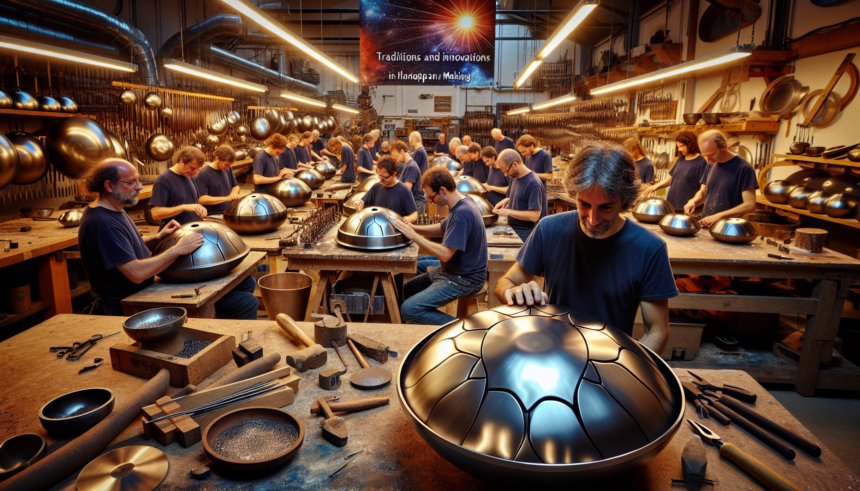<!DOCTYPE html>
<html lang="en">
<head>
<meta charset="UTF-8">
<meta http-equiv="X-UA-Compatible" content="IE=edge">
<meta name="viewport" content="width=device-width, initial-scale=1.0">
<title>Pantheon Steel Interview</title>
<style>
body {
font-family: Arial, sans-serif;
line-height: 1.6;
margin: 0;
padding: 20px;
color: #333;
background-color: #f9f9f9;
}
article {
max-width: 800px;
margin: 0 auto;
background: white;
padding: 20px;
box-shadow: 0 0 10px rgba(0, 0, 0, 0.1);
}
h2 {
color: #0056b3;
}
h3 {
color: #0056b3;
}
p {
text-align: justify;
}
</style>
</head>
<body>
<article>
<h2>Interview with Pantheon Steel: Innovations and Traditions in Handpan Making</h2>
<p>Pantheon Steel, established in 2004, has been a beacon of innovation and tradition in the sphere of handpan making. Known primarily for their flagship product, the Halo, Pantheon Steel has attracted a significant following among musicians and enthusiasts of this unique instrument. In this exclusive interview, we delve into the craftsmanship, innovations, and traditional elements that define Pantheon Steel’s legacy in the world of handpans.</p>
<h3>The Genesis of Pantheon Steel: Blending Art and Craftsmanship</h3>
<p>The story of Pantheon Steel begins with Kyle Cox, the founder and creative force behind the company. In an era where the steel pan was predominantly associated with the Caribbean's rich musical heritage, Cox envisioned a broader horizon for this melodic percussion instrument. In the early 2000s, handpans started to capture the imagination of the global music community, and Cox sought to differentiate Pantheon Steel by integrating a fine balance of traditional craftsmanship and modern innovation.</p>
<p>According to Cox, from the outset, the aim was to craft an instrument that resonated not just with clarity and harmony but also held in its form the spirit of innovation. “It’s about more than just creating a sound,” Cox says. “It’s about creating an experience that aligns with the musician’s intentions and extends to the listener’s soul.”</p>
<h3>Innovation in Handpan Design and Production</h3>
<p>Handpan design and production involve complex processes that demand precision and an acute sensitivity to acoustic detail. Pantheon Steel employs cutting-edge techniques alongside traditional methods to achieve the rich resonance for which the Halo is renowned. Cox elaborates that every Halo embodies a unique character, achieved through meticulous tuning and refinement processes.</p>
<p>One of the significant innovations introduced by Pantheon Steel includes its proprietary approach to material selection and shaping. “The choice of steel and its subsequent treatment determine much of the instrument's eventual sonorous quality,” explains Cox. “Our method combines multiple treatments to strengthen and enhance the tonal consistency across a wide array of pitches.”</p>
<p>Moreover, Pantheon Steel has been at the forefront of leveraging technology to enhance handpan making without compromising on artisanal quality. They incorporate precise digital tuning technology to complement the manual tuning process, ensuring each Halo maintains a perfect pitch.</p>
<h3>Maintaining Tradition While Embracing Change</h3>
<p>While Pantheon Steel actively adopts innovative techniques, the company remains deeply invested in handpan's traditional artistry. The creation of a Halo is indelibly linked to the handcraftsmanship that defines its essence, as each handpan is painstakingly hand-hammered and tuned by skilled artisans. This blend of old-world skill and new-world innovation results in instruments that not only sound exquisite but also hold artistic aesthetic appeal.</p>
<p>“Every handpan is a testament to hours of manual labor and dedication,” Cox reflects. “It’s a reminder of the diligence, patience, and expertise passed down through generations, yet curated with today’s technological prescience.”</p>
<h3>Community and Culture: The Heart of Pantheon Steel</h3>
<p>The spirit of community forms the fulcrum of Pantheon Steel’s philosophy. The production process involves collaboration not only among craftsmen but also with musicians who intimately understand the instrument's dynamics. This spirit of inclusivity fosters a vibrant exchange of ideas and techniques, bringing together artists, artisans, and innovators.</p>
<p>Cox believes that the handpan community transcends geographic and cultural boundaries. “Music, in its purest form, is universal. The handpan community thrives on the connections fostered through shared passion and artistry. Our journey is continuously enriched by our conversations and collaborations with musicians worldwide,” he shares.</p>
<h3>The Future of Handpans: Continuing the Legacy</h3>
<p>Looking ahead, Pantheon Steel is committed to both innovation and cultural preservation. They foresee further advancements in material sciences and acoustic research shaping the landscape of handpan fabrication. However, Cox emphasizes that any technological evolution will always honor the fundamental elements of handpan making that have endured time.</p>
<p>“Our goal is to maintain the integrity of the handpan while adapting to the possibilities that technology offers,” notes Cox. “Future innovations will serve to enhance, not replace, the core essence that defines these instruments.”</p>
<h3>Conclusion</h3>
<p>Pantheon Steel stands as a testament to the harmonious blend of innovation and tradition. Through a deep commitment to craftsmanship, community, and ongoing development, they have carved a niche in the musical world. Their dedication to creating handpans that harmonize with a musician’s vision ensures that the spirit of music continues to evolve while remaining rooted in its rich, timeless traditions.</p>
<h3>FAQs</h3>
<h4>1. What is a handpan?</h4>
<p>A handpan is a melodic percussion instrument made from steel. It is often characterized by its ethereal, resonant sound and is played by hand, unlike traditional steel pans that are played with mallets.</p>
<h4>2. How is a handpan different from a steel pan?</h4>
<p>While both instruments are made from steel, a handpan is played with the hands and is often tuned to a different scale, providing a more meditative sound. A steel pan, on the other hand, is played with mallets and is typically used in the vibrant, rhythmic music of the Caribbean.</p>
<h4>3. Why are handpans expensive?</h4>
<p>Handpans are handcrafted instruments that require extensive knowledge, skill, and time to produce. The materials used and the tuning process add to the instrument's cost, reflecting the craftsmanship involved in its making.</p>
<h4>4. How should I care for my handpan?</h4>
<p>To care for your handpan, store it in a protective case when not in use, clean it regularly with a microfiber cloth, and keep it away from extreme temperatures and humidity to prevent rust and damage.</p>
<h4>5. Can I tune my handpan myself?</h4>
<p>Tuning a handpan requires specialized knowledge and skills. It is advisable to have your handpan tuned by a professional tuner to ensure it maintains its optimal sound quality.</p>
</article>
</body>
</html>Interview with Pantheon Steel: Innovations and Traditions in Handpan Making

Leave a comment




